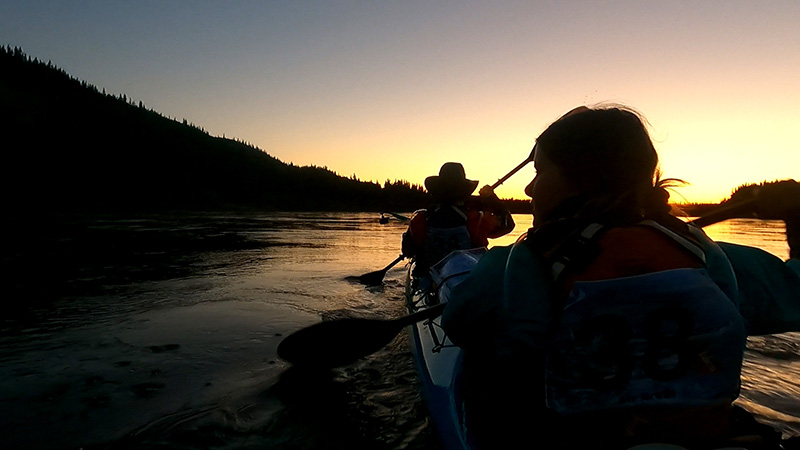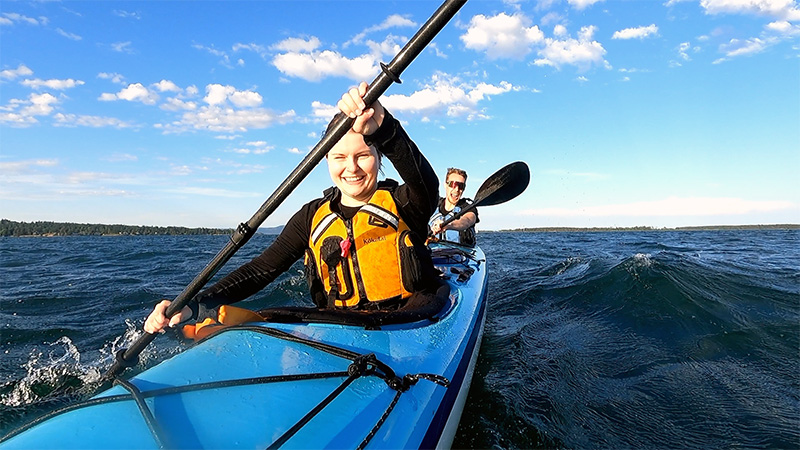Kayaking offers a unique blend of adventure and tranquility. As your paddle slices through the water, you engage nearly every muscle in your body. A full-body workout improves cardiovascular health, tones muscles, and boosts endurance. A kayak camping trip is the ultimate outdoor activity!
But beyond the physical benefits, kayaking provides the psychological benefits of a mental escape. When the weather conditions are right, the rhythmic sound of paddling and the sights of nature can be profoundly calming, reducing stress and enhancing mental focus.
Developing Mindset: An Approach to Kayaking for Beginners

Still image from the documentary, Power Quest: Adventure of a Lifetime, by Dave Stephens © Collaborative Film Productions, 2024
Kayaking is more than just a way to enjoy the great outdoors; it’s an incredible opportunity to challenge both your body and mind.
Many beginners approach kayaking with the question, ‘Can I do this?’—a question that often stems from underestimating their own abilities.
According to research shared in Carol S. Dweck’s book, Mindset: The New Psychology of Success, people often tend to greatly underestimate their capabilities. By adopting a growth mindset, you can push past self-doubt and embrace the perseverance and resilience needed to master kayaking.
A growth mindset is the belief that your abilities and intelligence can be developed over time through effort, learning, and persistence. Instead of thinking that you’re either “good” or “bad” at something, a growth mindset encourages you to see challenges as opportunities to improve.
If you’re learning to kayak and you struggle at first, having a growth mindset about it would mean that you understand that it’s okay to make mistakes because each mistake is a chance to learn and get better.
Having a growth mindset means believing that you can grow and improve, no matter where you start. By practicing, staying positive, listening to your body and being open to feedback, you can gradually build your skills and confidence on the water in no time.
Getting Started with Kayaking
Kayaking is a fun and rewarding outdoor activity that’s completely accessible to beginners. When learning to kayak, developing and maintaining a positive, success-oriented mindset is just as important as mastering the physical skills involved.
In the documentary, Power Quest: Adventure of a Lifetime, our film’s heroes, Madison and Jeremy, tackled the 715-km Yukon River Quest—an intense marathon paddling race—without any prior experience. They spent months preparing and training for this wilderness adventure, both mentally and physically. Their entire journey was captured by their father, first-time filmmaker Dave Stephens.
With a lot of preparation, encouragement, and support, Madison and Jeremy completed the race along the Yukon River, paddling from Whitehorse to Dawson City in 76 hours!
While not everyone may want to begin with paddling the world’s most gruelling outdoor adventure race, you might be wondering if learning to kayak is something you can do.
In this article, we’ll explore some of the challenges and benefits of kayaking, along with practical tips for getting started.
Remember, adopting a success mindset will greatly enhance your kayaking journey.
This beginner’s guide will help you develop both the physical skills and the mindset necessary to start your kayaking journey with confidence. Here, we’ll answer some of the most commonly asked questions about kayaking for beginners and provide tips to help you get started.
Is Kayaking Hard?
When it comes to learning anything new, there is generally a learning curve where it feels hard at the beginning and then gets easier over time and with practice.
Learning to kayak is generally not hard, especially if you start in calm waters and take the time to learn the basics. Most people find that with a bit of practice, they can quickly get the hang of paddling techniques, steering, and balancing in the kayak.

Is Kayaking Good Exercise?
Kayaking is not just a fun and adventurous outdoor activity; it’s also an excellent full-body workout that offers numerous physical benefits.
Whether you’re paddling along a calm lake or tackling a river’s swift currents, kayaking engages multiple muscle groups and provides a comprehensive cardiovascular fitness routine.
Physical Benefits of Kayaking
Kayaking is a fun and adventurous outdoor activity that also provides numerous physical benefits. Kayaking engages multiple muscle groups, providing a full-body workout!
Muscle Groups Used During Kayaking:
-
- Arms and Shoulders: kayaking involves working the muscles in your arms and shoulders. As you pull the paddle through the water with each stroke, your biceps, triceps, and shoulder muscles are put to work. This repetitive motion helps to strengthen and tone these areas over time.
-
- Core Muscles: kayaking constantly works your abs, obliques, and lower back. These muscles help stabilize your body as you paddle and maintain balance in the kayak. The act of rotating your arms while paddling provides a great way to strengthen your core, and having a strong core is crucial for overall stability and posture.
-
- Legs and Lower Body: in kayaking your legs play an important role as well. You use your legs for support against the kayak, which helps in stabilizing your body while also contributing to overall lower body strength.
Cardiovascular Benefits
In addition to building muscle, kayaking is an excellent cardiovascular workout, which we all know is essential to maintaining good health.
With regular practice, you can increase your stamina and endurance over time, making it easier for your heart and lungs to function efficiently. This also helps to reduce the risk of heart disease, lower blood pressure, and improve circulation.
Kayaking is a highly effective form of exercise that combines the benefits of a full-body workout with cardiovascular conditioning. It’s an enjoyable way to stay active, build strength, and improve overall fitness!
How to Choose a Kayak
The first step to a successful and enjoyable kayaking experience is choosing the right kayak.
For beginners, recreational kayaks are ideal. They are stable, easy to maneuver, and perfect for calm waters, making them the best kayak types for novices on their first paddling trips.
Two main types of kayak models exist:
-
- Sit-on-Top Kayaks: The first type is sit-on-top kayaks. They are easy to use and simple to get in and out of, and generally wider and very stable, which makes them a popular choice for beginners. Most have holes that allow water to drain out, so you don’t have to worry about the kayak filling up with water. They are great in a variety of conditions, including calm lakes, rivers, and coastal waters.
-
- Recreational, Sit-in Kayaks: The second type is sit-in kayaks. Recreational, sit-in kayaks offer great weather protection and often have a large cockpit (opening), making them easy to get in and out of. They are designed for stability and ease of use, with a wide hull. This makes them less likely to tip over. They are best suited for calm waters like lakes, gentle rivers, and bays, and great for casual paddling or short trips.
What to Wear Kayaking
Wearing the right clothing and gear while kayaking ensures you stay comfortable and safe on the water. Quick-drying layers, sun protection, and a well-fitted life jacket are must-haves for your adventure on the water. Here’s a checklist for what you’ll need to wear for a safe, fun experience:
-
- Essential Clothing:
-
- Quick-Drying Fabrics: Choose clothes made from materials like nylon or polyester that dry quickly and wick moisture away from your skin.
-
- Layering: Dress in layers to adapt to changing weather conditions. Start with a lightweight base layer, add a warmer middle layer like fleece if needed, and top it off with a waterproof jacket to protect against wind and water.
-
- Sun Protection: Wear a hat, sunglasses, and apply waterproof sunscreen to shield yourself from the sun’s rays, even on cloudy days.
-
- Life Jacket (Personal Flotation Device):
-
- Always wear a properly fitted life jacket designed for kayaking. It should be comfortable, allow easy movement, and be approved by safety standards. A good life jacket is essential for your safety regardless of your skill level.
Quick Guide to Beginner Kayaking Essentials
| Category | Item | Description | Tips for Beginners |
| Kayak Types | Sit-on-Top Kayak | A stable and user-friendly kayak, perfect for beginners, and ideal for warm climates and calm waters. | Look for models with good back support and easy access to the water. |
| Sit-in Kayak | Designed with a wide and stable hull, making them less likely to tip over. Easy to maneuver. Perfect for calm waters like lakes, slow-moving rivers, and ponds. | Start with shorter tours before venturing into longer trips. | |
| Paddles | Double-Bladed Paddle | The most common type, used for general kayaking. | Choose a lightweight paddle that’s easy to handle for long periods. |
| Safety Gear | Personal Flotation Device (PFD) | Essential for safety, keeps you afloat in case of capsizing. | Make sure your PFD fits snugly but comfortably. |
| Helmet | Important for kayaking in rough waters or rivers with potential obstacles. | Consider a helmet if you’re kayaking in fast-moving waters or near rocky areas. | |
| Clothing | Quick-Dry Clothing | Lightweight, moisture-wicking fabrics that dry quickly, keeping you comfortable on the water. | Avoid cotton; opt for synthetic fabrics or specialized kayaking gear. |
| Water Shoes or Sandals | Footwear that provides good grip and protects your feet in and out of the kayak. | Choose shoes with non-slip soles and good drainage. | |
| Accessories | Dry Bag | A waterproof bag for keeping your belongings dry, like your phone, keys, and snacks. | Invest in a quality dry bag to avoid any water damage to your essentials. |
| First Aid Kit | A compact kit with basic supplies for treating minor injuries while kayaking. | Make sure it’s waterproof and easily accessible. | |
| Mindset Tools | Goal-Setting Journal | A journal to track your progress, set kayaking goals, and reflect on your experiences. | Regularly update your journal to stay motivated and monitor your growth. |
| Mindset: The New Psychology of Success by Carol S. Dweck | A recommended read to help develop a growth mindset, not just for kayaking, but for life. | Apply the concepts in the book to your kayaking journey to overcome challenges. |
Must Have Kayak Accessories
When it comes to enhancing your kayaking experience, having the right gear can make all the difference. Here is a handy checklist of essential accessories every kayaker should consider!
Embracing a Success Mindset: The First Step in Your Kayaking Journey
Success in kayaking isn’t just about learning how to paddle—it’s about having the right mindset. According to Carol S. Dweck’s book, Mindset: The New Psychology of Success, adopting a growth mindset means believing that your abilities can improve with effort and learning.
By embracing a success mindset, beginners can overcome the initial hurdles of kayaking, set and achieve ambitious goals—like learning new paddling techniques or completing longer trips—and enjoy the physical, mental, and emotional rewards of the sport.
This mindset helps beginners overcome challenges and continue improving their skills. Whether you’re aiming to master new techniques or tackle longer kayaking trips, a success mindset will keep you motivated and resilient.
Your journey not only begins on the water but within your mind.
Start your kayaking journey with the belief that you can grow, take action by signing up for a lesson or setting a new goal, and share your progress to inspire others.
To learn more about kayaking and adventures on the water, follow us on Facebook and Instagram, and join our newsletter to stay tuned for news and updates about the Power Quest: Adventure of a Lifetime documentary!
